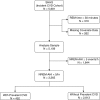Obstructive Sleep Apnea during REM Sleep and Cardiovascular Disease
- PMID: 29112823
- PMCID: PMC6005240
- DOI: 10.1164/rccm.201706-1112OC
Obstructive Sleep Apnea during REM Sleep and Cardiovascular Disease
Abstract
Rationale: Obstructive sleep apnea (OSA) during REM sleep is a common disorder. Data on whether OSA that occurs predominantly during REM sleep is associated with health outcomes are limited.
Objectives: The present study examined the association between OSA during REM sleep and a composite cardiovascular endpoint in a community sample with and without prevalent cardiovascular disease.
Methods: Full-montage home polysomnography was conducted as part of the Sleep Heart Health Study. The study cohort was followed for an average of 9.5 years, during which time cardiovascular events were assessed. Only participants with a non-REM apnea-hypopnea index (AHI) of less than 5 events/h were included. A composite cardiovascular endpoint was determined as the occurrence of nonfatal or fatal events, including myocardial infarction, coronary artery revascularization, congestive heart failure, and stroke. Proportional hazards regression was used to derive the adjusted hazards ratios for the composite cardiovascular endpoint.
Measurements and main results: The sample consisted of 3,265 subjects with a non-REM AHI of less than 5.0 events/h. Using a REM AHI of less than 5.0 events/h as the reference group (n = 1,758), the adjusted hazards ratios for the composite cardiovascular endpoint in those with severe REM OSA (≥30 events/h; n = 180) was 1.35 (95% confidence interval, 0.98-1.85). Stratified analyses demonstrated that the association was most notable in those with prevalent cardiovascular disease and severe OSA during REM sleep with an adjusted hazards ratio of 2.56 (95% confidence interval, 1.46-4.47).
Conclusions: Severe OSA that occurs primarily during REM sleep is associated with higher incidence of a composite cardiovascular endpoint, but in only those with prevalent cardiovascular disease.
Keywords: REM sleep; cardiovascular disease; sleep apnea; sleep heart; sleep-disordered breathing.
Figures
Comment in
-
Obstructive Sleep Apnea and Cardiovascular Disease. REM Sleep Matters!Am J Respir Crit Care Med. 2018 Mar 1;197(5):554-556. doi: 10.1164/rccm.201710-2147ED. Am J Respir Crit Care Med. 2018. PMID: 29141154 Free PMC article. No abstract available.
References
-
- Carberry JC, Hensen H, Fisher LP, Saboisky JP, Butler JE, Gandevia SC, et al. Mechanisms contributing to the response of upper-airway muscles to changes in airway pressure. J Appl Physiol. 1985;2015:1221–1228. - PubMed
-
- Grace KP, Hughes SW, Horner RL. Identification of the mechanism mediating genioglossus muscle suppression in REM sleep. Am J Respir Crit Care Med. 2013;187:311–319. - PubMed
-
- Somers VK, Dyken ME, Mark AL, Abboud FM. Sympathetic-nerve activity during sleep in normal subjects. N Engl J Med. 1993;328:303–307. - PubMed
Publication types
MeSH terms
Grants and funding
LinkOut - more resources
Full Text Sources
Other Literature Sources



